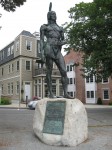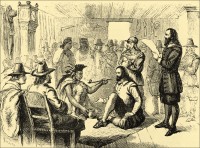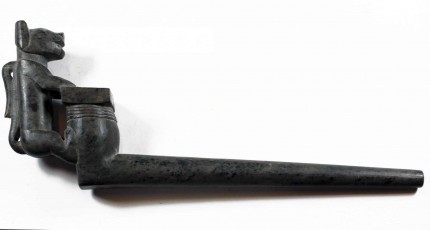 Artifacts and remains of the Wampanoag leader who forged the first alliance with the Pilgrims are being reburied in his original grave after a two-decade search for the scattered relics.
Artifacts and remains of the Wampanoag leader who forged the first alliance with the Pilgrims are being reburied in his original grave after a two-decade search for the scattered relics.
The Pilgrims called him Massasoit as if it were his first name and it has stuck, but in fact it’s a hereditary title meaning “Great Leader.” His name was Ousamequin. As Great Leader of the Pokanoket Wampanoags, he held the allegiance of numerous chieftains and villages in the Wampanoag Confederation stretching from Narragansett Bay east to Cape Cod, most of modern-day southeastern Massachusetts.
In the six years before the Mayflower landed at Plymouth, two smallpox outbreaks had decimated the Pokanoket, reducing their warrior ranks from a formidable 3,000 to a mere 300. With their enemies the Narragansetts at their doorstep (they controlled the territory west of Narragansett Bay), ready to take advantage of the Pokanoket’s military weakness, in March of 1621 Ousamequin entered into a treaty of nonaggression and mutual defense with the newly arrived English colonists. They agreed not to attack each other and to come to each other’s aid if either one were attacked by third parties.
 The English had weapons and the ability to use them; the Pokanoket knew how to grow, make and find food. The military alliance was advantageous to both, since the Narragansetts were as ill-disposed towards the English as they were toward the Pokanoket, and good relations with their indigenous neighbors were essential to the survival of the colony. Without them, the Plymouth colony would quickly go the way of their countrymen at Jamestown and starve to death. As it was, they only had a place to live because they had moved into a Pokanoket village (Patuxet) left abandoned after a smallpox epidemic, and although Ousamequin didn’t know this, at the time of the alliance barely three months after their arrival, almost half of the colonists and Mayflower crew had already died from diseases contracted during the Atlantic crossing.
The English had weapons and the ability to use them; the Pokanoket knew how to grow, make and find food. The military alliance was advantageous to both, since the Narragansetts were as ill-disposed towards the English as they were toward the Pokanoket, and good relations with their indigenous neighbors were essential to the survival of the colony. Without them, the Plymouth colony would quickly go the way of their countrymen at Jamestown and starve to death. As it was, they only had a place to live because they had moved into a Pokanoket village (Patuxet) left abandoned after a smallpox epidemic, and although Ousamequin didn’t know this, at the time of the alliance barely three months after their arrival, almost half of the colonists and Mayflower crew had already died from diseases contracted during the Atlantic crossing.
The alliance lasted 40 years, ending only with Massasoit Ousamequin’s death in 1661. English sources acknowledge that the colony would almost certainly have died on the vine in those difficult first few years without his invaluable aid and recognized him as a man of unimpeachable integrity, loyalty and generosity. That didn’t stop the growing colony from encroaching ever more on Pokanoket lands, of course, and as the decades passed, the alliance became increasingly strained. Under pressure from all sides, Ousamequin chose to keep the alliance together and repeatedly sold the colonists ever-larger sections of Pokanoket territory. In 1653, he and his eldest son Wamsutta sold land known as Sowams which included most of the present-day towns of Warren and Barrington, Rhode Island, and Somerset, Massachusetts, for 35 pounds sterling. The buyers were a who’s who of early New England history: Miles Standish, Josiah Winslow, William Bradford, John Winslow, et al.
 One small piece of Sowams was not part of the sale: the “neck,” meaning the uplands overlooking the bay. Called Montaup, anglicized as Mount Hope, this was Ousamequin’s hometown and was to be reserved for the Pokanoket until such time as they chose to leave. After his death, he was buried there. By the end of King Philip’s War (King Philip was the English name of Massasoit Metacom, Ousamequin’s second son, who took up arms against the Plymouth Colony in 1675 to stop their untrammeled expansionism) in 1678, the surviving Pokanoket fled to Maine and Mount Hope Neck was absorbed into Warren, Rhode Island.
One small piece of Sowams was not part of the sale: the “neck,” meaning the uplands overlooking the bay. Called Montaup, anglicized as Mount Hope, this was Ousamequin’s hometown and was to be reserved for the Pokanoket until such time as they chose to leave. After his death, he was buried there. By the end of King Philip’s War (King Philip was the English name of Massasoit Metacom, Ousamequin’s second son, who took up arms against the Plymouth Colony in 1675 to stop their untrammeled expansionism) in 1678, the surviving Pokanoket fled to Maine and Mount Hope Neck was absorbed into Warren, Rhode Island.
 Neglected and unprotected, Massasoit Ousamequin’s grave was destroyed during construction of the Providence, Warren and Bristol Railroad, which opened in Warren on July 4th, 1851, 190 years after Massasoit’s death. His wasn’t the only grave on the hilltop, and souvenir hunters and archaeologists (who at this time were also largely souvenir hunters) dug up the site, collecting artifacts and human remains which wound up dispersed throughout personal collections and museums.
Neglected and unprotected, Massasoit Ousamequin’s grave was destroyed during construction of the Providence, Warren and Bristol Railroad, which opened in Warren on July 4th, 1851, 190 years after Massasoit’s death. His wasn’t the only grave on the hilltop, and souvenir hunters and archaeologists (who at this time were also largely souvenir hunters) dug up the site, collecting artifacts and human remains which wound up dispersed throughout personal collections and museums.
In 1990, the Native American Graves Protection and Repatriation Act made it federal law that grave goods and human remains held in collections, institutions of learning and museums be returned to related tribes for reburial according to their religious traditions.
Members of the Wampanoag Nation have spent 20 years tracking down the remains and artifacts of Massasoit Ousamequin. It was their “spiritual and cultural obligation,” said Ramona Peters, who coordinated the effort. […]
Ousamequin’s artifacts include a pipe, knife, beads and arrowheads.
The Rhode Island Historical Society has repatriated about 75 items to the appropriate tribes since the law’s passage, including artifacts belong [sic] to Ousamequin. They were donated as relics in the 1800s, but collections aren’t assembled in that way today, said Kirsten Hammerstrom, director of collections.
“Grave goods are not something we dig up and accept. They belong to the tribe,” she said. […]
The Wampanoags have collected hundreds of funerary objects that were removed from the burial ground on the hill and held dozens of burials for their ancestors whose graves were disturbed, Peters said.
“It is an honor and a privilege to be able to do this for our ancestors,” she said.
Now it’s Massasoit Ousamequin’s turn.

For this very interesting information, let us “give thanks”!
Talking of Indigenous Americans, I am unfamiliar with the website I’ve linked to below. Is this story worth taking seriously?
http://nativesnewsonline.com/2017/04/16/dna-scientists-claim-that-cherokees-are-from-the-middle-east/
Nope. There is no attribution, no names, no links to supporting research, no attributed quotes. The site is a new one, and appears to be an automatically generated aggregation of any news mentioning native americans. There is no editorial staff. The “admin” appears to be software. There is nobody there.
This story looks to me like a reprisal of some old claims from early 1800s, adopted by the Mormons as part of their mythology. Those claims have been handily disproved by DNA and archaeology. Some similar, more recent claims have been made by various authors about the origins of some of the hill country groups (collectively and colloquially known as “Melungeons” that developed in the Carolinas during and after slavery. The groups are real, but the claims about their origins have been debunked as well– by DNA analysis, among other research strategies.
There has been quite a bit of intriguing DNA work about indigenous Americans in recent years, including the clear demonstration that there is continuity in DNA from ancient remains with modern Native Americans. You should be able to find solidly researched articles (with citations and actual authors)in any college or university library.
As for Lucius’ article about the return of grave artifacts belonging to Ousamequin and other Native Americans, and their reburial, I am happy to see this. Since I will be in the area this summer (seeking my own ancestors), I will be able to stop by and pay my respects by honoring both him and his descendants who have made this happen.
Amazing – I had no idea there was even consensus on where Ousamequin was buried (originally). Awful that his grave was treated so poorly in the 19th century, but standard in those days.
I didn’t realize that the colony at Jamestown starved and failed? Being a descendant of a settler at Jamestown who was farming there while the Pilgrims were hiding out in Holland, I find this bit of information rather odd?
@Bruce; didn’t the first colony at Jamestown fail and the second succeed?
That still leaves the second as essentially the founding colony – older than anything in Massachusetts. But the South lost the Civil War so Massachusetts won the propaganda war. Hence the fuss about The Pilgrims, Thanksgiving etc etc.
Yes and no. They packed up to leave, set off down the James with the folks who ran aground in Bermuda a few months before and encountered Lord De La Warre’s relief fleet coming up the river. They never made it off the James or out of the Colony much to the Powhatan’s dismay. One of the great accidents of American history.
I like to keep the Yankee Imperialists on their toes. Now if we could only get them out of Florida and the Carolina’s. They can’t drive and no one can understand a thing they say.
Nobody Disrespects The Yankee Imperialists!
They like to forget about the Jamestown settlement because it ended in disaster and Cannibalism. The National mythology of the American origin story could not be based upon the Jamestown colony, so they instead used the successful Massachusetts Bay Colony.
How would you feel if someone said your ancestors are not real. They are as fake as mine. Books and colleges are not where all information is. History was written by the winners. Whether your proof is in a book or not we were not there. The same people that write these books also read our DNA. They say it is true so it must be true. Why don’t you think before you write rude and arrogant opinions. I am an Ancestor of Massasoit. Why are we Pockonockets not recognized for the first Thanksgiving. Oh right because some DNA says we don’t even exist. History keeps repeating itself. I will finish with your ancestors did not live where you think they lived and the DNA proves that they never even existed.